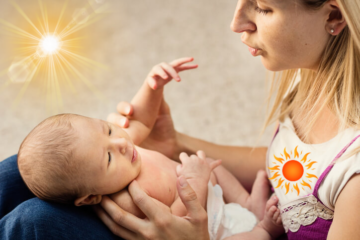Bathing a baby can be a delightful and bonding experience. Here’s a step-by-step guide to help you bathe your baby safely:
Before You Begin:
Gather Supplies:
– Mild baby soap or cleanser
– Soft washcloths
– Baby shampoo
– Towels
– Clean diaper
– Clean clothes
Baby lotion (optional)
-
Ensure a Warm Room:
Keep the room comfortably warm, around 75°F (24°C).
Bathing Process:
-
Prepare the Bath:
Fill a baby tub or the sink with a few inches of warm (not hot) water (around 37-38°C or 98-100°F). Test the water temperature with your elbow to ensure it’s not too hot.
-
Undress Your Baby:
Choose a warm room and undress your baby, leaving the diaper on until the last moment.
-
Support the Head:
Hold your baby securely with one hand supporting their head and neck. Use the other hand to guide them into the water, feet first.
-
Wash the Face First:
Use a damp cloth or cotton ball to gently wipe your baby’s face. Start from the eyes and move outwards, using a different part of the cloth for each eye.
-
Wash the Body:
Use a mild baby soap or cleanser on a soft washcloth to clean your baby’s body. Pay attention to folds, such as neck and armpits, but be gentle.
-
Shampoo the Hair:
If your baby has hair, use a tear-free baby shampoo to wash their hair. Support the head with one hand and gently pour water over the head, avoiding the face.
-
Rinse and Pat Dry:
Rinse your baby thoroughly with clean water, making sure to remove all soap. Lift them out of the water and pat them dry with a soft towel, paying attention to all creases.
-
Diaper and Dress:
Place a clean diaper under your baby and dress them in clean, dry clothes.
-
Apply Lotion (Optional):
If your baby’s skin tends to be dry, you can apply a mild, fragrance-free baby lotion.
Safety Tips:
Never Leave Your Baby Alone:
Even for a moment, never leave your baby unattended in the bath.
Maintain a Secure Grip:
Always keep a secure hold on your baby, especially when moving them in and out of the water.
Check Water Temperature:
Always check the water temperature before placing your baby in the bath.
Keep Supplies Within Reach:
Have all necessary supplies within arm’s reach to avoid leaving your baby unattended.
Use Mild Products:
Choose gentle, hypoallergenic baby products to minimize the risk of irritation.
Remember, every baby is different, and it may take a few tries to find a routine that works best for both you and your baby. As your baby grows, you can adjust the bathing routine to suit their developmental stage.
Benefits of bathing baby daily
While bathing a baby daily might not be necessary, there are benefits to regular, gentle bathing as part of a routine. Keep in mind that newborns and infants have delicate skin, and excessive bathing could lead to dryness or irritation. Here are some potential benefits of bathing your baby regularly:
-
Maintaining Skin Hygiene:
Regular bathing helps keep your baby’s skin clean and free from dirt, sweat, and bacteria.
-
Stimulation and Relaxation:
Bath time can be a soothing and enjoyable experience for both you and your baby, promoting relaxation and bonding.
-
Establishing a Routine:
A consistent bathing routine can become a calming part of your baby’s daily schedule, signaling the transition to bedtime or other activities.
-
Promoting Better Sleep:
For many babies, a warm bath can be a calming prelude to sleep. The change in body temperature as they come out of the warm water may mimic the natural drop in temperature that occurs before sleep.
-
Helping with Skin Conditions:
If your baby has skin conditions like cradle cap or mild diaper rash, regular bathing with mild, hypoallergenic products may help manage these issues.
-
Improving Circulation:
The gentle movement of the water and the massage effect of bathing can stimulate blood circulation in your baby’s body.
-
Opportunity for Sensory Exploration:
Bath time provides an opportunity for sensory exploration as your baby feels the water, experiences different textures, and observes their surroundings.
-
Learning and Development:
As your baby gets older, bath time can become a time for learning and play, with toys and interactive activities helping to develop motor skills and coordination.
Tips for Bathing Frequency:
Newborns (0-3 months): Two to three baths per week are generally sufficient, as newborns don’t get very dirty and excessive bathing can strip their delicate skin of natural oils.
3-6 Months: You can gradually increase the frequency as your baby becomes more active or if they enjoy bath time.
6-12 Months: At this stage, you can bathe your baby a few times a week, adjusting based on their needs and your routine.
Remember to always use mild, hypoallergenic products and consult with your pediatrician if you have concerns about your baby’s skin or if they have specific skin conditions. Each baby is unique, and what works for one may not work for another, so it’s important to observe your baby’s cues and adjust your routine accordingly.




